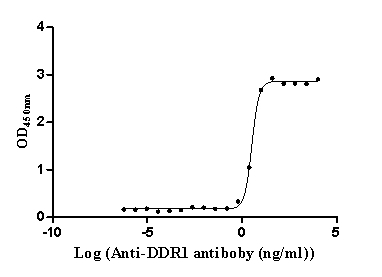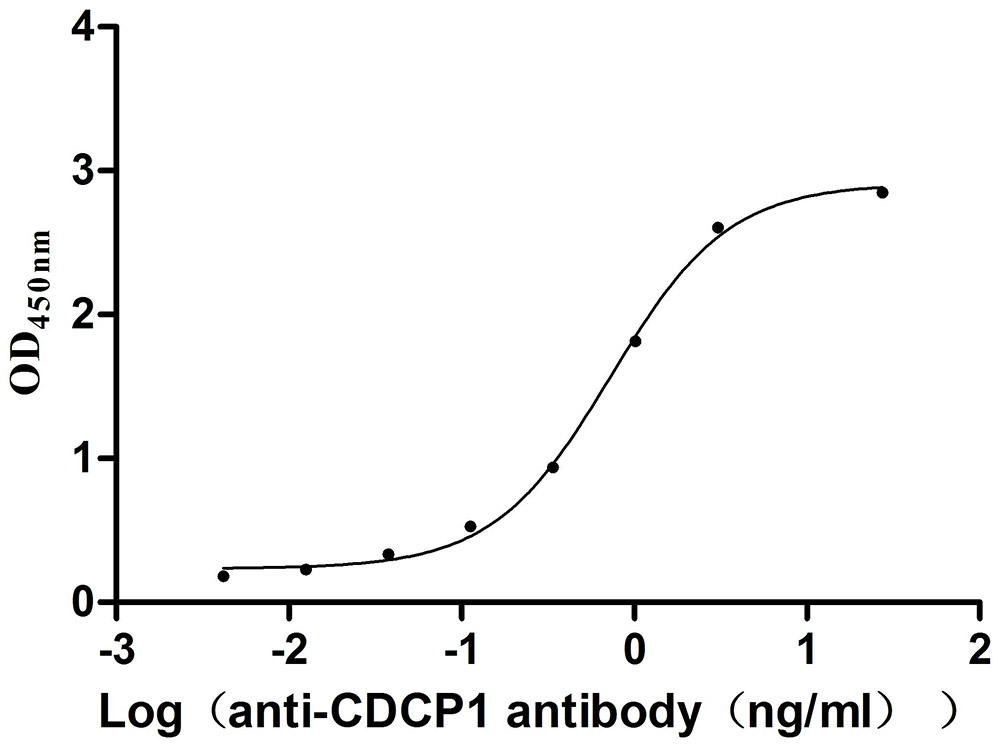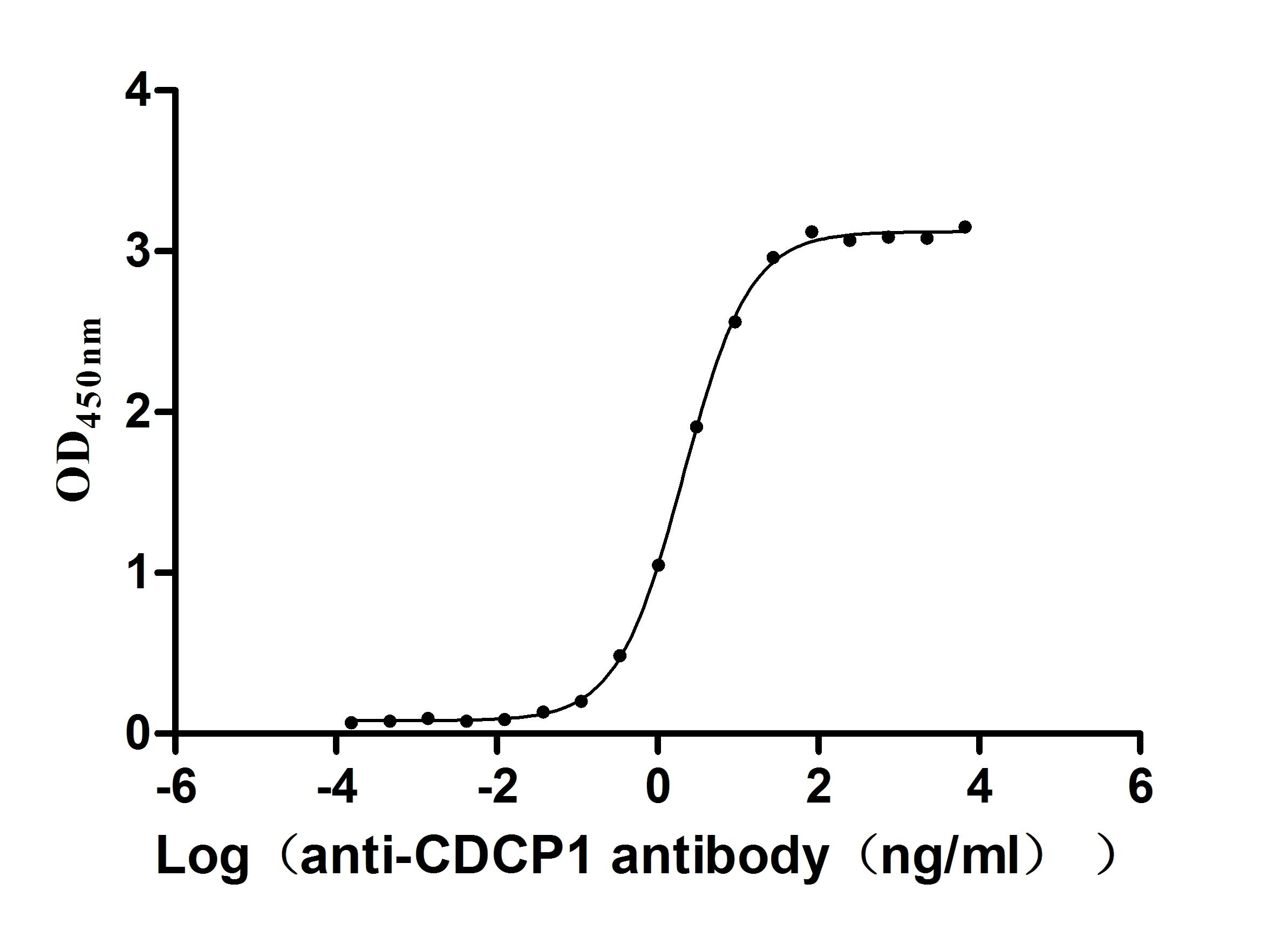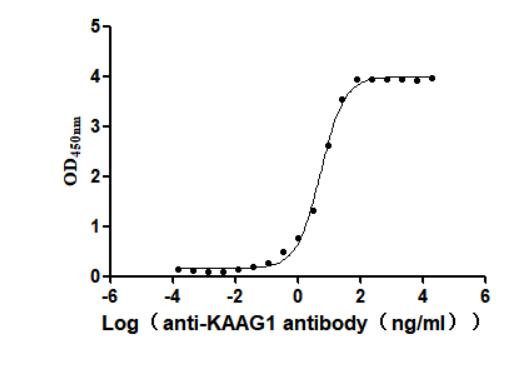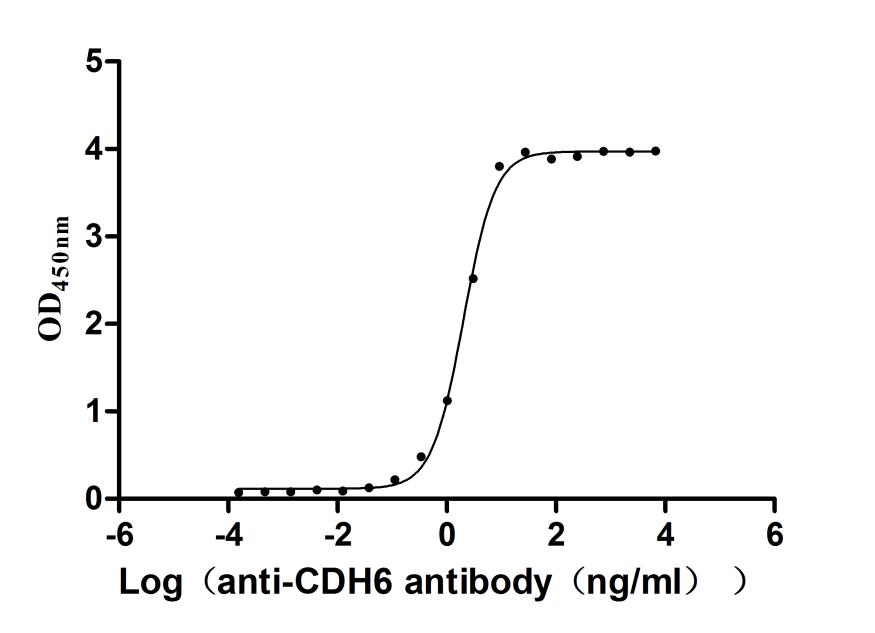Recombinant Mouse Metalloproteinase inhibitor 3 (Timp3)
-
中文名称:小鼠Timp3重组蛋白
-
货号:CSB-YP023562MO
-
规格:
-
来源:Yeast
-
其他:
-
中文名称:小鼠Timp3重组蛋白
-
货号:CSB-EP023562MO-B
-
规格:
-
来源:E.coli
-
共轭:Avi-tag Biotinylated
E. coli biotin ligase (BirA) is highly specific in covalently attaching biotin to the 15 amino acid AviTag peptide. This recombinant protein was biotinylated in vivo by AviTag-BirA technology, which method is BriA catalyzes amide linkage between the biotin and the specific lysine of the AviTag.
-
其他:
-
中文名称:小鼠Timp3重组蛋白
-
货号:CSB-BP023562MO
-
规格:
-
来源:Baculovirus
-
其他:
-
中文名称:小鼠Timp3重组蛋白
-
货号:CSB-MP023562MO
-
规格:
-
来源:Mammalian cell
-
其他:
产品详情
-
纯度:>85% (SDS-PAGE)
-
基因名:Timp3
-
Uniprot No.:
-
别名:Timp3; Sun; Timp-3; Metalloproteinase inhibitor 3; Tissue inhibitor of metalloproteinases 3; TIMP-3
-
种属:Mus musculus (Mouse)
-
蛋白长度:Full Length of Mature Protein
-
表达区域:24-211
-
氨基酸序列CTCSPSH PQDAFCNSDI VIRAKVVGKK LVKEGPFGTL VYTIKQMKMY RGFSKMPHVQ YIHTEASESL CGLKLEVNKY QYLLTGRVYE GKMYTGLCNF VERWDHLTLS QRKGLNYRYH LGCNCKIKSC YYLPCFVTSK NECLWTDMLS NFGYPGYQSK HYACIRQKGG YCSWYRGWAP PDKSISNATD P
-
蛋白标签:Tag type will be determined during the manufacturing process.
The tag type will be determined during production process. If you have specified tag type, please tell us and we will develop the specified tag preferentially. -
产品提供形式:Lyophilized powder
Note: We will preferentially ship the format that we have in stock, however, if you have any special requirement for the format, please remark your requirement when placing the order, we will prepare according to your demand. -
复溶:We recommend that this vial be briefly centrifuged prior to opening to bring the contents to the bottom. Please reconstitute protein in deionized sterile water to a concentration of 0.1-1.0 mg/mL.We recommend to add 5-50% of glycerol (final concentration) and aliquot for long-term storage at -20℃/-80℃. Our default final concentration of glycerol is 50%. Customers could use it as reference.
-
储存条件:Store at -20°C/-80°C upon receipt, aliquoting is necessary for mutiple use. Avoid repeated freeze-thaw cycles.
-
保质期:The shelf life is related to many factors, storage state, buffer ingredients, storage temperature and the stability of the protein itself.
Generally, the shelf life of liquid form is 6 months at -20°C/-80°C. The shelf life of lyophilized form is 12 months at -20°C/-80°C. -
货期:Delivery time may differ from different purchasing way or location, please kindly consult your local distributors for specific delivery time.Note: All of our proteins are default shipped with normal blue ice packs, if you request to ship with dry ice, please communicate with us in advance and extra fees will be charged.
-
注意事项:Repeated freezing and thawing is not recommended. Store working aliquots at 4°C for up to one week.
-
Datasheet :Please contact us to get it.
相关产品
靶点详情
-
功能:Complexes with metalloproteinases (such as collagenases) and irreversibly inactivates them by binding to their catalytic zinc cofactor. May form part of a tissue-specific acute response to remodeling stimuli.
-
基因功能参考文献:
- Loss of TIMP3 is associated with germinal matrix hemorrhage-intraventricular hemorrhage. PMID: 29456135
- altered cortical and trabecular bone mineralization and increased compositional heterogeneity were found in Timp-3 (-/-) bone, all being indicative of high bone remodeling PMID: 28236102
- In a clinically relevant CADASIL mouse model, we show that exogenous ADAM17 or HB-EGF restores cerebral arterial tone and blood flow responses, and identify upregulated voltage-dependent potassium channel (KV) number in cerebral arterial myocytes as a heretofore-unrecognized downstream effector of TIMP3-induced deficits. PMID: 27476853
- TIMP3 promotes normal microvascular endothelial cell barrier function, at least partially, through inhibition of metalloproteinase-dependent disruption of adherens junctions, and septic downregulation of TIMP3 may contribute to septic MVEC barrier dysfunction. PMID: 26993226
- data strongly suggest that TIMP3 has direct neuroprotective effects that can mitigate the deleterious effects associated with TBI, an area with few if any therapeutic options. PMID: 26299440
- Elevated levels of TIMP3 and vitronectin, acting downstream of Notch3(ECD) deposition, play a role in CADASIL, producing divergent influences on early CBF deficits and later white matter lesions. PMID: 26648042
- 4-Hydroxyisoleucine improved insulin resistant-like state in 3T3-L1 adipocytes by targeting TACE/TIMP3 and the insulin signaling pathway. PMID: 26527864
- In a mouse model of prostate cancer, increased tumor growth, proliferation index, increased microvascular density, and invasion was observed in Pten(-/-), Timp3(-/-) prostate tumors compared to Pten(-/-), Timp3(+/+) tumors. PMID: 26332574
- Timp3 status determines p53, p38 and Notch coactivation to instruct hepatic cell fate and transformation. PMID: 25347747
- lack of TIMP3 increases inflammation and polarizes macrophages towards a more inflammatory phenotype resulting in increased atherosclerosis. PMID: 24943223
- TIMP-3 KO mice exhibit enhanced metabolism, as reflected by a higher body temperature than WT mice, possibly due to increased mitochondrial activity. PMID: 24736588
- TIMP3 protects kidney from damage PMID: 23760282
- TIMP3 reduction is due, at least in part, to increased expression of certain TIMP3-targeting microRNAs in diabetic kidneys compared to healthy controls. PMID: 23797704
- Demonstrate a critical role for TIMP3, among all TIMPs, in preserving arterial remodelling in response to Ang II-induced hypertension. PMID: 23524300
- TIMP-3 functions to moderate the differentiation of macrophages into proinflammatory (M1) cells. PMID: 23742180
- DNA methylation changes were noted in the Timp3 gene during chronic cystitis in a murine model. PMID: 23806407
- Loss of Timp3 gene leads to abdominal aortic aneurysm formation in response to angiotensin II. PMID: 23144462
- Loss of TIMP3 selectively exacerbates diabetic nephropathy. PMID: 22896043
- Pericyte-derived TIMP3 stabilized and ADAMTS1 destabilized the capillary tubular networks PMID: 22383695
- we show that TIMP3 produced by the hepatic stroma regulates the basal lymphocyte populations in the liver and prevents autoimmune hepatitis PMID: 22323541
- Data suggest that focal ischemia leads to proliferation of immature oligodendrocytes in white matter and that TIMP-3 contributes to a caspase-3-dependent immature OL death via TNF-alpha/TACE-mediated neuroinflammation. PMID: 21871134
- macrophage-specific overexpression of TIMP3 protects from metabolic inflammation and related metabolic disorders such as insulin resistance, glucose intolerance, and nonalcoholic steatohepatitis. PMID: 22228717
- TIMP3 differentially impacts apoptosis and inflammatory cell influx, based on involvement of TNF, during the process of mammary involution. PMID: 22053204
- macrophage-specific overexpression of TIMP3 decreases the inflammatory content and the amplitude of atherosclerotic plaques in low-density lipoprotein receptor knockout mice PMID: 22015660
- Placental growth factor finely tunes a balanced regulation of the tissue inhibitor of metalloproteinases-3/tumor necrosis factor-alpha-converting enzyme axis and the consequent TNF-alpha activation in response to transverse aortic constriction. PMID: 21900081
- TIMP3 was identified as a potential miR-206 target by TargetScan prediction analysis; further, in cultured cardiac fibroblasts, miR-206 gain- and loss-of-function studies and luciferase reporter assays showed that TIMP3 is a direct target of miR-206. PMID: 21731608
- deficiency in TIMP-3 increases cardiac rupture post-myocardial infarction PMID: 21243368
- Timp3, an endogenous regulator of metalloproteinases, stimulates hematopoietic stem cells proliferation by recruiting quiescent hematopoietic stem cells into the cell cycle. PMID: 20798233
- demonstrated that TNF signaling promoted hepatotoxicity, while excessive TNF receptor 1 (TNFR1) shedding in Timp3-/- mice was protective. PMID: 20628198
- TIMP3 functions to promote the resolution of inflammation in the lung. PMID: 20008147
- We have identified novel mechanisms, governed by the TACE-Timp3 interaction, involved in the determination of insulin resistance and liver steatosis during overfeeding in mice. PMID: 19877183
- Overexpression of TIMP-3 can inhibit angiogenesis and associated tumor growth, and that the antiangiogenic effects of TIMP-3 appear to be mediated through the inhibition of functional capillary morphogenesis. PMID: 12384438
- The gene expression and protein distribution of Timp-3 was analyzed during molar development. PMID: 12950084
- TIMP-3 deficiency disrupts matrix homeostasis and the balance of inflammatory mediators, eliciting the transition to cardiac dilation and dysfunction. PMID: 15262835
- Here we show that deletion of the mouse gene Timp3 resulted in an increase in TNF-alpha converting enzyme activity, constitutive release of TNF and activation of TNF signaling in the liver. PMID: 15322543
- Timp3 has a role in diabetes and vascular inflammation through the insulin receptor and TNF-alpha PMID: 16294222
- loss of TIMP3 impacts innate immunity by dysregulating cleavage of TNF and its receptors PMID: 16393953
- TIMP-3 provides an inherent regulation over the kinetics of pro-MMP-2 processing, serving at a level distinct from that of TIMP-2 and TIMP-4 PMID: 16469749
- TIMP-3 regulates MMP-2 activation to limit tumor cell extravasation and subsequent colonization of the lung, without augmenting inflammatory cell response. PMID: 16702949
- Timp-3 plays an important role in the maintenance of renal macrostructure after unilateral ureteral obstruction PMID: 16778336
- TIMP3 can indirectly regulate epithelial cell proliferation via MMP inhibitory activity. While others have demonstrated that TIMP3 controls proliferation in vitro, this is the first evidence of TIMP3 regulating proliferation in vivo. PMID: 16890932
- TIMP3 has a role in the pericyte-induced stabilization of newly formed vascular networks that are predisposed to undergo regression and reveal specific molecular targets of the inhibitors regulating these events. PMID: 17030988
- Physiologically, Timp3(-/-) mammary glands displayed accelerated mammary ductal elongation during pubertal morphogenesis. PMID: 17327279
- Results indicate that TIMP-3 deficiency results in mild cartilage degradation similar to changes seen in patients with osteoarthritis. PMID: 17328064
- Laparotomy induced a downregulation of TIMP-3 and an upregulation of PI3-kinase, which increased cancer cell growth, invasion and cell cycle activity in comparison to laparoscopy. PMID: 17342361
- The alveolar macrophage is essential for the TIMP-3 null sepsis-induced compliance alterations. PMID: 17586692
- Timp-3 plays an important role in L-NAME-induced hypertension and myocardial vascular remodeling. PMID: 17664861
- Role of DPPI and TIMP-3 in development of pulmonary fibrosis in early inflammation following bleomycin instillation. PMID: 17673693
- TIMP-3 deficiency accelerated maladaptive cardiac remodeling after a myocardial infarction by promoting matrix degradation and inflammatory cytokine expression. PMID: 17945252
- TIMP-3 facilitates Fas-mediated neuronal cell death following oxigen-glucose deprivation and plays a pro-apoptotic role in mild cerebral ischemia PMID: 17962815
显示更多
收起更多
-
亚细胞定位:Secreted, extracellular space, extracellular matrix.
-
蛋白家族:Protease inhibitor I35 (TIMP) family
-
组织特异性:Highest levels are found in kidney, lung and brain followed by ovary and uterus. Low levels are found in bone.
-
数据库链接:
KEGG: mmu:21859
STRING: 10090.ENSMUSP00000020234
UniGene: Mm.4871
Most popular with customers
-
Recombinant Human Claudin-9 (CLDN9)-VLPs (Active)
Express system: Mammalian cell
Species: Homo sapiens (Human)
-
Recombinant Human Epithelial discoidin domain-containing receptor 1 (DDR1), partial (Active)
Express system: Mammalian cell
Species: Homo sapiens (Human)
-
Recombinant Human C-C chemokine receptor type 8 (CCR8)-VLPs (Active)
Express system: Mammalian cell
Species: Homo sapiens (Human)
-
Recombinant Mouse CUB domain-containing protein 1 (Cdcp1), partial (Active)
Express system: Mammalian cell
Species: Mus musculus (Mouse)
-
Recombinant Macaca fascicularis CUB domain containing protein 1 (CDCP1), partial (Active)
Express system: Mammalian cell
Species: Macaca fascicularis (Crab-eating macaque) (Cynomolgus monkey)
-
Recombinant Human C-C chemokine receptor type 6(CCR6)-VLPs (Active)
Express system: Mammalian cell
Species: Homo sapiens (Human)
-
Recombinant Human Kidney-associated antigen 1(KAAG1) (Active)
Express system: Baculovirus
Species: Homo sapiens (Human)
-
Recombinant Mouse Cadherin-6(Cdh6),partial (Active)
Express system: Mammalian cell
Species: Mus musculus (Mouse)



